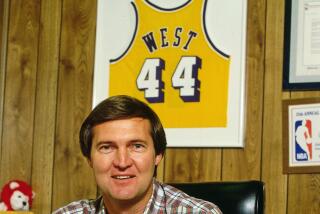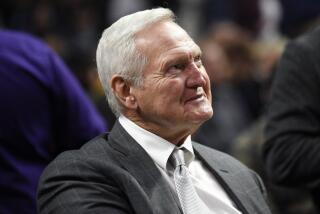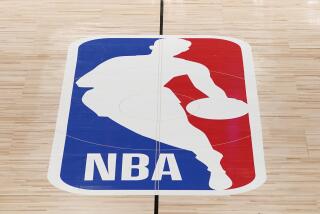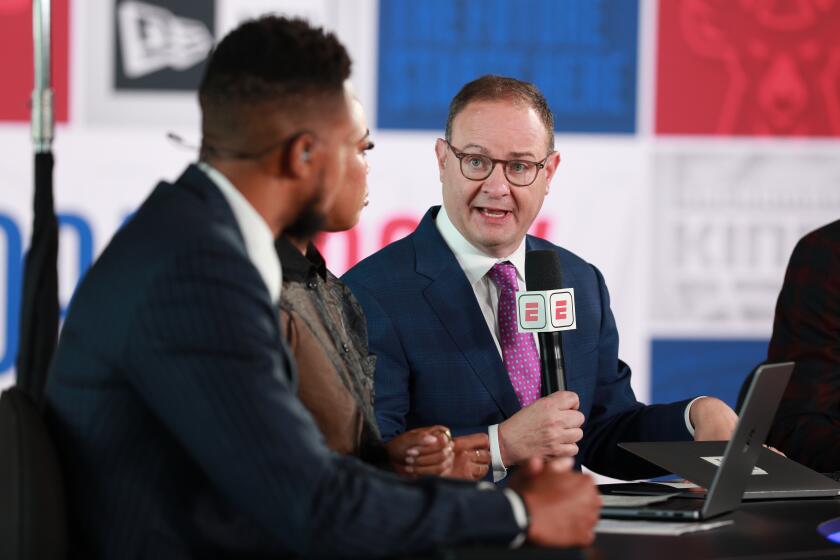Back in the Day, Mikan Was the Man in the NBA
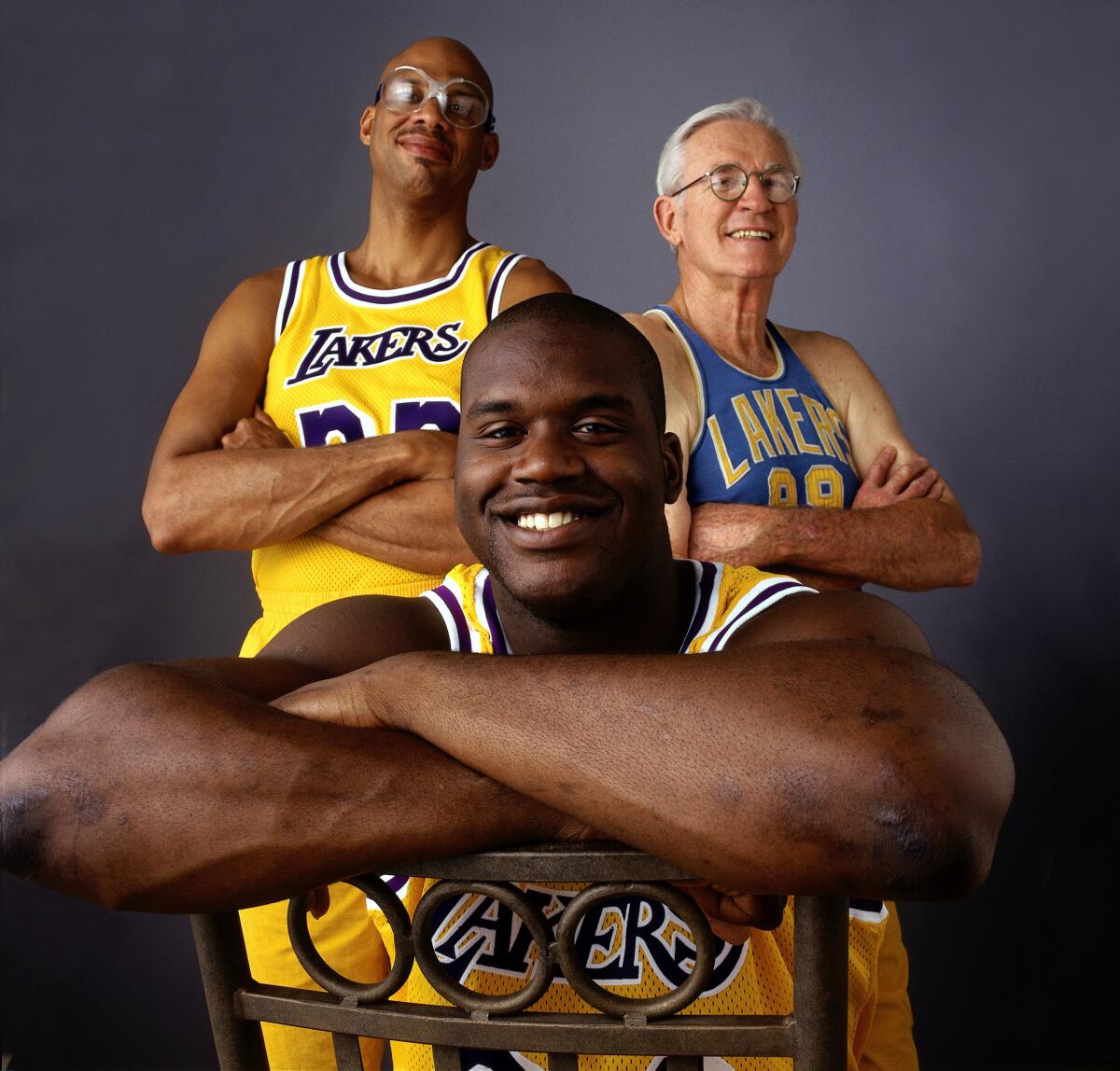
George Mikan died at age 80 this week, too soon for those who were close to him but, fortunately, not too soon for the Lakers, the NBA and everyone who benefited from this giant man who altered basketball.
They all had chances to pay their respects to him in the latter years of his life, before the diabetes whittled him down and the kidney problems took him away.
I remember the touching sight of Bill Russell helping Mikan step up to the stage so he could stand alongside the rest of the NBA’s 50 greatest players in a halftime ceremony at the 1997 All-Star game. It was an understated moment, a little payback from one of the great centers to his predecessor.
Mikan is at the roots of the NBA’s big-man family tree. From him, it branches out and the arguments grow. Russell or Wilt Chamberlain? Shaquille O’Neal? Kareem Abdul-Jabbar? Moses Malone? Hakeem Olajuwon? They all had their contemporaries, their rivals, arguments for and against being the best of their era or all time.
But there’s no debate about who came first and paved the way. George Mikan.
“He was a great hook-shot artist and he dominated,” said Harvey Pollack, the statistician and public relations man who has worked in the NBA in some form or fashion since the league’s inception. “There was no comparable center of his stature until Wilt came along.”
He received another tribute at the overdue -- but certainly not underdone -- homage to the Minneapolis Lakers at Staples Center on April 11, 2002, when the link from the franchise’s roots was officially acknowledged with a halftime ceremony that raised a banner to commemorate the five championships won in Minneapolis and another that honored their Hall of Fame coach and five Hall of Fame players, including Mikan.
Before the game, O’Neal -- wearing the evening’s throwback blue uniforms with “MPLS” on the front -- stepped into a darkened room to pose for pictures with Mikan. O’Neal doesn’t like to bow to anyone, but he knelt alongside Mikan, who was in a wheelchair. O’Neal flashed the big smile, then signed some autographs for Mikan’s family. He acknowledged that Mikan was the granddaddy of NBA centers.
O’Neal claims that he built Staples Center, but, in truth, neither that arena nor the Forum before it would have been constructed had it not been for Mikan. He was the league’s first marquee name -- literally, as the famous picture of the Madison Square Garden sign reading “Geo Mikan vs. New York Knicks” demonstrated. At 6 feet 10, Mikan established the NBA as the big man’s domain. He averaged 22.6 points a game, tame by today’s standards but dominant for his time.
In 1950, the Fort Wayne Pistons decided the only way to beat the Lakers was to keep the ball out of Mikan’s hands. So they held on to it as long as possible, shooting only when absolutely necessary.
The strategy worked -- the Pistons won, 19-18 -- but the thought of such low scores infuriated NBA President Maurice Podoloff, and for the 1954-55 season the league adopted the 24-second shot clock created by Syracuse National owner Danny Biasone.
Another rule change directly attributed to Mikan was the widening of the three-second lane from six feet to 12.
“His style of play is nonexistent today,” Pollack said. “No. 1, you can’t stand that close to the basket. Secondly, he was a big guy. He wasn’t the king of speed. He had a lot of weight.”
Pollack was struck by Mikan’s size even in the later years of his life. At an event during the NBA’s 50th anniversary season in 1996-97, Pollack found himself in a room with Mikan, Chamberlain, Russell and Julius Erving.
“[Mikan] was still big,” Pollack said. “Russell wasn’t that big. And [Mikan] was bulky. He had a lot of weight on him. Wilt was closer to him, but he was still broader than Wilt was. Wilt, of course, was taller than him [at 7-1].”
The sad thing was that even a child could stand taller than Mikan in his final wheelchair-bound years. One of his legs was amputated, then he suffered an infection in the other. The ceremony at Staples was one of his last public events.
As the NBA hit the big time in the 1980s, Mikan and the pioneers of his era -- his $12,000 contract made him the league’s richest player -- were often overlooked.
But the league and the players who commanded those multimillion-dollar salaries got it right by the end. He got the credit he deserved, even if he never received the commensurate amount of cash. He saw a statue of himself in Minneapolis. In Los Angeles, he saw his name go up beside those of his Laker descendants, Chamberlain and Abdul-Jabbar. His old black-and-white images even reappeared in NBA commercials.
“I’m very happy that the NBA has taken it upon itself to bring the history of the NBA up to speed so a lot of young people know what we had done,” he once said.
“The young people are finally starting to see some of those old films that were taken, and they’re starting to realize that they wouldn’t be there today if it were not for us. I felt like we were in the covered wagons that went across the United States.”
We’ve seen this week that there’s a strong drive to be acknowledged for one’s accomplishments, strong enough to drive “Deep Throat” himself out of the parking garage shadows and into the national spotlight three decades after his confidential tips to the Washington Post led to the toppling of a presidency.
Mikan received his due in due time, which is why we send him off with a eulogy, not an apology.
J.A. Adande can be reached at j.a.adande@latimes.com. To read previous columns by Adande, go to latimes.com/adande.
*
(BEGIN TEXT OF INFOBOX)
Before Wilt, Kareem and Shaq
Towering over most of his opponents, George Mikan was one of the most effective scorers of his day, averaging 22.6 points over a career that lasted nine years -- one with the Chicago American Gears and eight with the Minneapolis Lakers:
* Four-time NBA All-Star (1951-54).
* Five league titles with Minneapolis Lakers (1949-50, 1952-54).
* Led the league in scoring five times (1947-51), including a career-high 28.4 points a game in 1951.
* Led the league twice in rebounding average: 1953 (14.4) and 1952 (13.5).
* Annually one of the league leaders in free-throw attempts; 4,597 for career.
* Voted the game’s greatest player for the first half-century.
* NBA 50th Anniversary All-Time Team (1996).
Source: Basketballreference.com; NBA
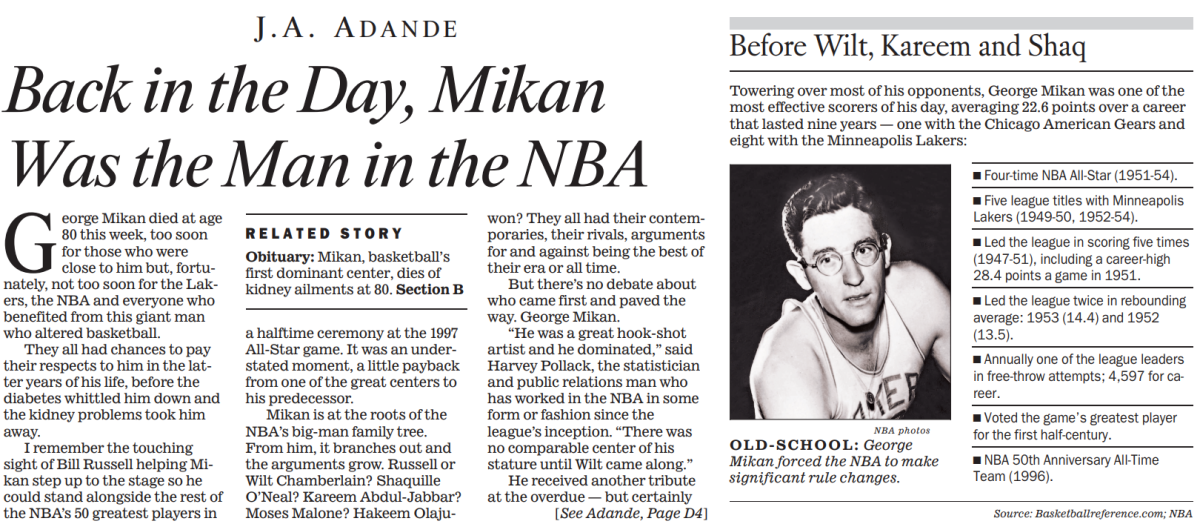
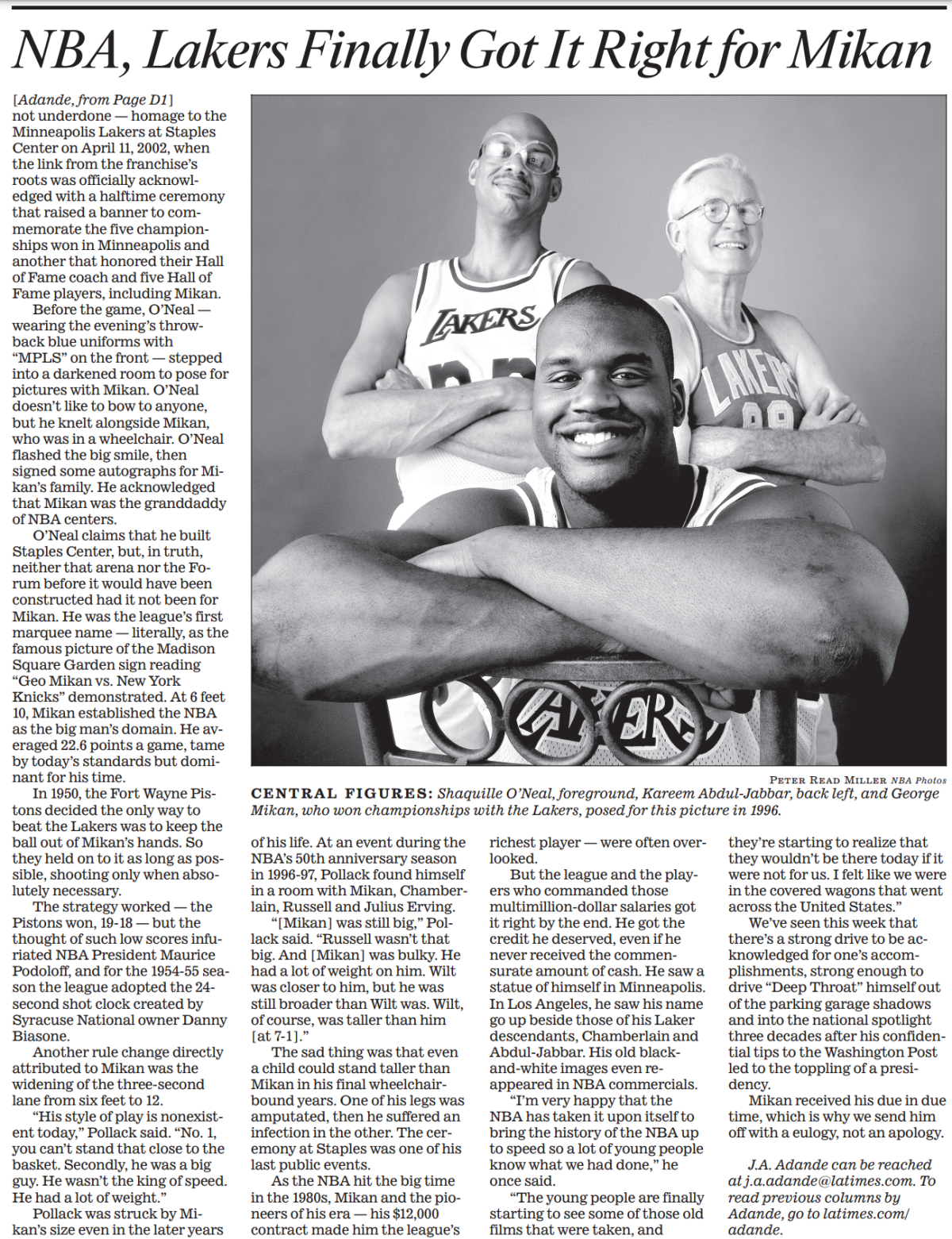
More to Read
All things Lakers, all the time.
Get all the Lakers news you need in Dan Woike's weekly newsletter.
You may occasionally receive promotional content from the Los Angeles Times.
